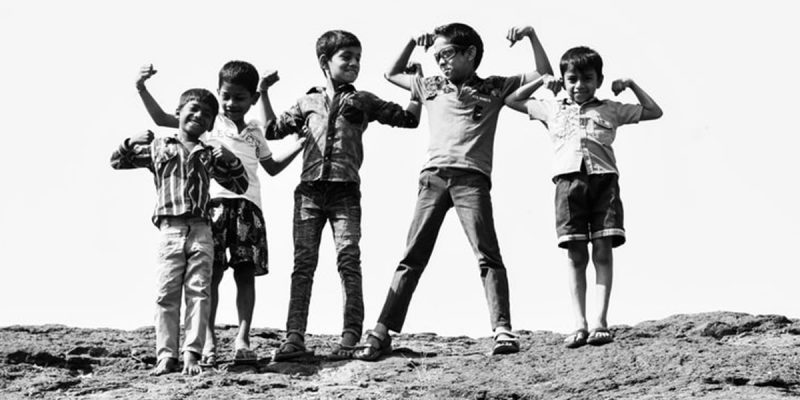Mitrabhanu Lenka, a student of class eight living in the Koraput district in Odisha, is on his bicycle every morning at 8. A journey of about thirty kilometres across the Odisha border to Andhra Pradesh lies ahead of him.
For the last six months, Lenka, 13, has undertaken this journey every day with a group of his friends in search of better mobile connectivity owing to patchy and inconsistent internet reception in his village.
His government-run school, like all other schools across India, was shut down due to the COVID-19 lockdowns. Even then, Lenka’s parents, who work as contractual farmers, have tried their best to keep him engaged in his studies.
On Lenka’s shoulders is a backpack that has his mobile phone, a notebook and pen, some food, and a mat made out of coconut husk. “When I get proper connectivity across the border, I stop there, sit on the mat and start making notes,” Lenka told Entrackr.
Since the pandemic caused all schools to shut down, the Odisha government has been streaming classes for Classes 1 to 10 on YouTube.
After running around to catch reception and scribble notes, Lenka and his friends spend an hour heading back home by around 4 pm. “Our fathers used to tell us stories about how they used to cross rivers to reach schools. When I and my friends have kids, we will tell them that we used to travel across states to attend an online class,” Lenka said.
While Lenka was outdoors and had to travel to a different state for his online education, about a thousand kilometres away, a young Rishabh Prajapati was sitting in the comfort of his home in Gurgaon attending virtual classes. While waiting for his next session on algebra due in twenty minutes, Prajapati decided to watch some videos on YouTube.
An average day in his life includes attending online classes organised by his private school in Haryana’s Gurugram and then taking an hour-long class on keyboard lessons from a private tutor organised on Zoom.
These two students represent the contrast crores of young children are experiencing on a daily basis over the last year. The story of India’s digital divide in access to education amid the pandemic reflects this massive divide. Learning gaps are opening up across age groups, expanding to become an insurmountable chasm in too many cases.
Data maintained by the United Nations Educational, Scientific and Cultural Organisation (UNESCO) shows that during the course of the pandemic, the education of over 32 crore children in India was impacted.
Some one thousand kilometres away from Rishabh and about five hundred kilometres away from Lenka, Sony Sanjukta, 15, who lives in a small village in Odisha called Rangamati, travels 5 kilometres every day to the adjoining state of Jharkhand for better internet connectivity.
Like Lenka’s village, Sanjukta’s village too has poor mobile reception. Entrackr couldn’t reach her on her mobile due to this poor connectivity for hours at a stretch on Monday.
While her journey is arduous, traversing through a forest, it helps her download all her online lessons onto her phone. After several hours, Sanjukta walks back home with her friends to study from these newly downloaded videos.
Sanjukta is among the majority of children in the block of Kutra who don’t have access to online classes. According to the central government’s own admission, Odisha had more than 6,000 villages without internet connectivity as of March 2021, the most of any Indian state. Internet subscribers per 100 population in the state at 43.95 are also considerably lower than the national average of 55.12.

On a national level, estimates suggest that a little less than half of India’s population has access to the internet. And the government’s plans to increase rural internet penetration under the BharatNet project have largely seen shifting goalposts and missed deadlines.
According to UNICEF, online education is not an option for all in India as only one in four children has access to digital devices and internet connectivity. All this in a country which incidentally is also home to two of the biggest edtech unicorns in the world.
While the situation seems temporary, it could have a long-lasting impact. With internet hurdles, experts say that children from marginalised communities in rural areas are more likely to drop out of schools.
“Segregation, discrimination and inequality is at the root itself of life in most Indian villages. And when you open up that kind of a system to online education, it is bound to have a very negative impact especially on marginalised and downtrodden people,” Dr Niranjanaradhya VP, the programme head for the universalisation of equitable quality education programme at NLSIU Bengaluru, told Entrackr.
“At no point do online classes serve the actual purpose of an education system. Socialisation, social transformation, understanding social realities, and developing critical thinking is in the essence of an education system and that can only happen when children come together to talk, debate, and argue,” said Dr Niranjanaradhya.
He further said that many children are already dropping out of school to join the labor workforce and some of the ways to avoid this is if the government would focus on increasing the daily wages under the National Rural Employment Guarantee Act.
“If you put people’s livelihood ahead of education then naturally they will prioritise survival,” said Dr Niranjanaradhya. “Help those families, give them some sort of a livelihood, have an accelerated learning program for kids who dropped out and ensure a robust monitoring mechanism across the cluster and block level.”
Some of Sanjukta’s friends have also dropped out of school. But she continues to stay motivated. “My parents have motivated me to keep my education up. A few children from our village have already stopped their studies and started helping their parents in the fields,” Sanjukta said.














